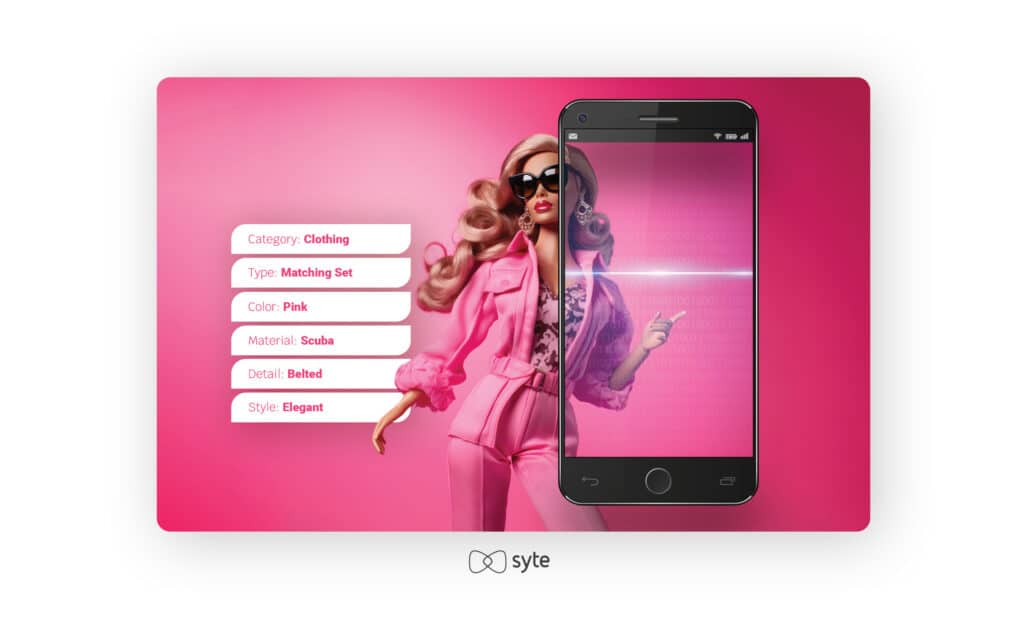Reaching $365 million worldwide, Barbie set blockbuster records as the highest-grossing debut for a movie directed by a woman. And behind nearly every ticket sold was a perfect pink outfit worn to the theatre and immortalized on Instagram.
Brands from Balmain to the Gap to Zara, and (many) more tried their luck at turning around clothing collabs to fuel consumer appetite for Barbie-based looks. But not all that is pink produces sales.
When managing inventory around trends, brands and retailers have to maintain a tricky balancing act: they need enough on-trend options to meet demand, but they have to exercise caution so as not to overproduce niche and hard-to-sell items. In this post, we’ll explore how the Barbie movie impacted shopping habits, reveal the specific styles that sold, and share how brands can keep tabs on trend cycles and ride the wave of cultural events like the Barbie movie as efficiently as possible.
Barbie’s Best Looks
Syte dug deep into the data to understand what shoppers were looking for leading up to the big debut. We compared sales from fast fashion brands during Q2 2022 and Q2 2023 to see which types of items saw a jump in sales ahead of the movie’s release, and found the following:
- Pink sequin dresses were up 26.2%
- Neon pink jumpsuits were up 52.6%
- Pink matching sets were up 73.5%
- Pink jumpsuits were up 62%
- Neon pink shirts and blouses were up 55.7%
- Pink skirts were up 66.8%
- Pink jewelry was up 131.4%
- Matching sets were up 11.9%
- Sequin dresses were up 14.4%
- Sparkly jumpsuits were up 75.9%
- Ruffle knit tops were up 51.9%
The Dollars Are in the Details
At a glance, it would be easy to assume that stocking up on pink clothing is a safe bet, but that would be a simplistic view of what shoppers truly crave. In the stats above, there are clear sub-trends that go beyond just “pink.” For example, neon pink and sequins are leading the way in terms of materials, and matching sets, skirts, and jumpsuits are far ahead of dresses. The same goes for accessories: it would be natural to make the leap that pink bags would do best, but in reality, pink jewelry sold surprisingly well. Without delving into the specifics, a brand that ordered pastel pink minidresses – an indisputably “Barbie-approved” style – would be disappointed to see that the stock they paid for was slow to move.
In order to successfully track the rise and fall of trends inspired by major cultural events, like the Barbie movie, brands need to be plugged into the unique combinations of details that shoppers are buying. The Barbie movie phenomenon also highlights the need for brands to be agile and adaptive in their approach to inventory management — but they need the right technology in place to stand a fair chance.
Keeping Track of Trends with Visual AI
Going beyond the SKU level to track the sale of aesthetic details, shades, and materials demands technology that can identify those details and aggregate the data on what consumers are looking for. Visual AI harnesses the power of artificial intelligence to analyze vast amounts of visual data, including the hemlines, sleeve styles, textures, and cuts in product images. With visual AI analyzing a brand’s catalogue, each item in their inventory is assigned a detailed data set that enables a deeper understanding of its performance.

The same technology can be used to analyze social media images, influencer posts, runway looks, and more. For example, by using image recognition algorithms, brands can identify the most popular jumpsuit or skirt styles worn by influencers, celebrities, or ordinary consumers leading up to and during movie releases, concert tours, and other cultural moments. Armed with this data, retailers can produce items that include the same visual details, riding the trend effectively, preventing stockouts, and maximizing sales.
Visual AI can even assist in identifying concepts for engaging displays that resonate with customers’ current preferences. By analyzing images and videos from the Barbie movie and related social media posts, brands can design visually appealing storefronts and online visuals that capture the essence of the trend and effectively communicate the message to potential buyers.
Getting Ahead of the Next Trend
The Barbie movie phenomenon serves as a compelling example of how a cultural event can swiftly and significantly impact consumer shopping trends. To navigate such seismic shifts successfully, brands must embrace agility and leverage technologies like visual AI to keep track of emerging trends in real-time. By being prepared to adjust inventory, revamp visual merchandising, and seize social media opportunities, brands can not only meet customer demands but also establish themselves as trendsetters in the competitive world of fashion and retail. The combination of cultural awareness and the power of advanced AI is a winning formula that can ensure brands remain efficient, relevant, and successful in the ever-evolving landscape of consumer preferences.